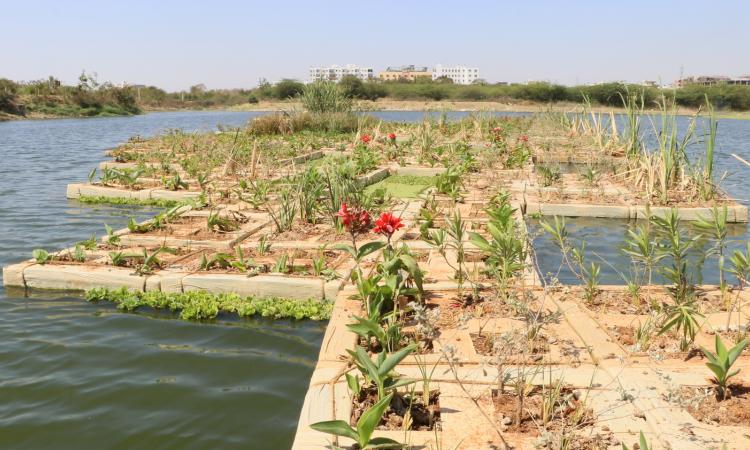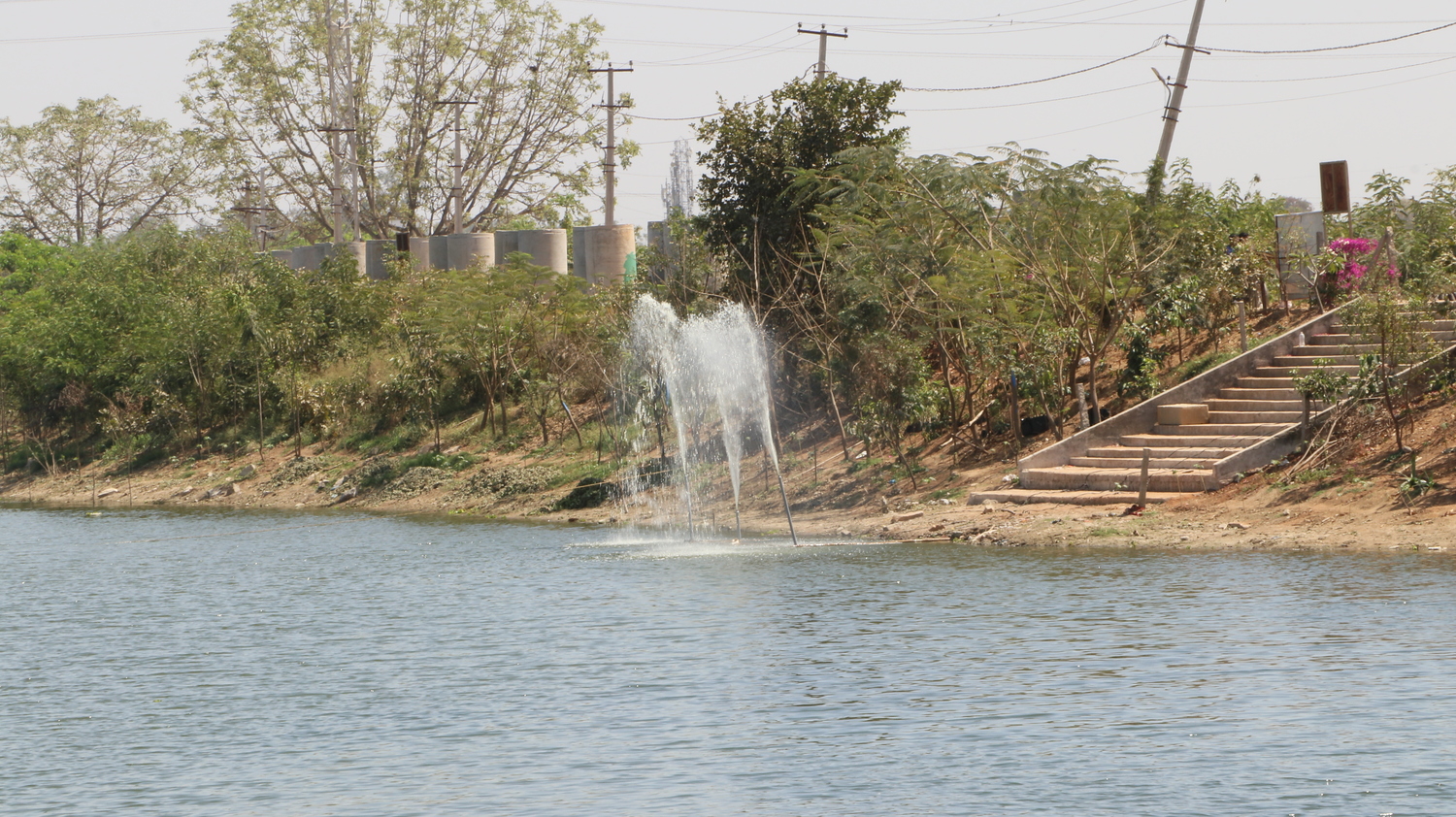
A radical new method is fast emerging as an effective and sustainable solution to increasing pollution in urban lakes. Called floating treatment wetlands (FTW), they are artificial islands with plants that stay afloat on the lake. The plants clean the lake through hydroponics system, resulting in a cleaner, beautiful lake and an improved habitat for creatures that depend on it. We have already heard of this being successfully implemented in Hauz Khas lake in Delhi. The latest one to benefit from this treatment method is Neknampur Lake on the outskirts of Hyderabad city.
Inaugurated on February 2, 2018, on World Wetlands Day, the Neknampur FTW has been recognised as the largest of its kind in the country by The India Book of Records. It’s the creation of Dhruvansh, an NGO, that along with the Hyderabad Metropolitan Development Authority (HMDA) and district authorities, has been working to revive the lake since 2016.
Untreated sewage pollutes the lakes
Ibrahim Bagh river is a 100-acre water body situated in Neknampur village in Rangareddy district of Telangana. It consists of two distinct water bodies--chinna cheruvu (small river), also called Neknampur lake covering 25 acres, and pedda cheruvu (big river) of around 75 acres. While chinna cheruvu has been transformed into a beautiful lake, pedda cheruvu is still used as a garbage dump and is choked with hyacinth.
There were many reasons why the lake was polluted. Untreated sewage from the nearby Alkapur township apartments flows into the lake which was the number one cause.
The residents of the surrounding areas used to dump their garbage, too in the lake. “When we sought help from government authorities to clear the garbage, it took them 10 trucks and 15 days to do it. We also found dead bodies of animals and human remains in the lake,” says Madhulika Chowdary, founder of Dhruvansh.
“Diverting sewage is not a solution as you will end up polluting another water body,” she explains. “A sewage treatment plant (STP) is costly to build and maintain and it does not remove pathogens and the metallic content. So, we chose this biological sewage treatment method based on hydroponics technique that cleans the lake by absorbing nutrients dissolved in the water and thereby supporting living species inside the lake.”
What is a floating treatment wetland?
The FTW is an ingenious bamboo raft with its sides made of thermocol blocks and plastic bottles which are chemically inert. A layer of gunny sacking stretches across the raft’s bottom to create a tray that holds a two-centimetre layer of gravel. Saplings have been planted in the soil with their roots reaching into the water.
This 3000 sq. ft. raft supports around 3500 saplings of different varieties. These include wetland plants, mosquito repellents and ornamental plants like cattails, bulrush, citronella, canna, hibiscus, fountain grass, flowering herbs, tulsi and ashwagandha. The plants absorb the high levels of phosphorus and nitrogen in the sewage water entering the lake.
The FTW costs a fraction of what a conventional sewage-treatment plant would cost. The first FTW, with 140 saplings, was introduced in May 2017 in a small area of the lake and it showed remarkable results. The team then increased its size to hold 3500 saplings.
Another unique feature of the restoration process is the way water hyacinth is used to clean the lake. Water hyacinth is usually seen as a problem because it chokes water bodies and destroys other aquatic life. “If we can use hyacinth in a creative way, it can play a major role in cleaning the lake by absorbing the pollutants in the sewage. We have cleared 80 percent of the hyacinth in the lake but have let the remaining 20 percent to grow. We are using the cleared weed as an organic manure by mixing it with cow dung to grow plants both in the FTW and in the surroundings,” says Madhulika.
Besides the FTW, Dhruvansh is also using aerators to oxygenate the water. They have also planted more than 5000 shrubs around the lake. The combination of all these measures has had a positive impact on the lake. The latest reports from the Telangana state pollution control board (ref to the reports of water quality tests--done at the inlet and outlet of the lake--attached below) show significant improvement in the quality of water. “The lake has so much biodiversity, with 178 species of birds, 41 species of reptiles, pythons, mongoose, mammals and it is increasing by the day,” says a jubilant Madhulika.
This project, however, has had its share of controversies. A group of citizens has raised concerns over the use of thermocol or styrofoam in creating the base of the wetland. Some even suggest that recycled plastic bottles and mesh would have been a better option since thermocol is an environmental hazard. P. Veeranna, the joint chief environmental scientist at TSPCB, however, assures that there is no such danger. He says that the styrofoam base is covered with plastic and both do not react with the water or pollute the lake.
Says Shilpa Sharma, the regional coordinator of the Telangana state biodiversity board, "Thermocol does not cause any harm to the lake restoration process. Even if it is in direct contact with the water, it does not pollute the water as it is not soluble in water. Except when it is broken into small pieces; then there might be a chance of fish eating the small pieces of thermocol. But at Neknampur lake, they have properly managed it by closing the thermocol with the plastic sheet base. The Neknampur lake was black and filled with sewage when I visited it one and a half years ago. But when I attended the FTW inauguration on February 2, I saw a lot of progress in the lake."
Clean lakes benefit people
The lake has not only contributed to the biodiversity and beautification but it has also helped some of the locals earn a living. “This lake was clean long back but deteriorated later due to sewage and other pollutants,” says Suresh who fishes in the lake. “We had released small fish in the lake in the past but they died. Now as the lake is clean, I am planning to grow fish in it again.”
This initiative has gained attention from many volunteers and college students who are now working with the organisation in cleaning the lake and maintaining the plantation. “When I first visited the lake one-and-a-half years ago, the lake was full of sewage and hyacinth. I have seen the lake gradually turn into a beautiful one,” says Vamsi M., a volunteer.“This has become a tourist place now with many people visiting it. We have many volunteers who work with us every Saturday and Sunday in plantation and in cleaning the lake. We have also conducted many programmes for school children to create awareness about our responsibility towards the ecosystem,” she adds.
“Being a commerce student, I didn’t know anything about the lake and pollutants,” says Vishal, a student from IIMC college in Hyderabad. “After joining the team, I have learnt that sewage water is just a combination of nitrates and phosphates and with the help of FTW that contains wetland plants, those chemicals can be eliminated.”
The initiative has also gained recognition from the government which contributed Rs 5 lakh towards the FTW and Rs 1.8 lakh for cleaning the lake. “We welcome NGOs like Dhruvansh to adopt lakes and work for their restoration,” says T. Chiranjeevulu, HMDA commissioner. “We have sanctioned around Rs 12 lakh for the work and we are very happy with this innovative technique at a minimal cost. We are also planning to start the restoration of 10 other lakes in Hyderabad this year,” he says.
(Mahesh Bacham is a Bangalore-based freelance writer and a member of 101Reporters.com, a pan-India network of grassroots reporters.)
Report from TSPCB attached below: